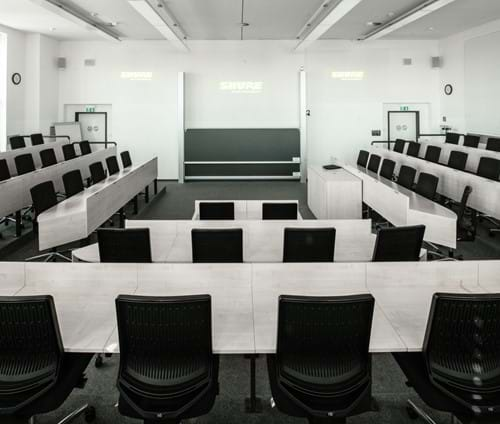How an Audio Ecosystem Can Accelerate Transformation in Higher Education

It’s all change for Higher Education AV technology. IT/AV decision makers in learning institutions are being tasked with adapting, upgrading, even replacing existing solutions to support a new, hybrid (at home/in-class) learning and teaching model. Further, the rapid uptake of remote learning has necessitated a rethink about the type of AV capability needed to maximize investments in software video conferencing platforms (e.g. Zoom, MS Teams) that are keeping students engaged in learning.
There is no doubt that high-quality audio makes a positive impact on remote learning and collaboration. Thus, Higher Education institutions are looking to integrate these platforms with effective, networked technology that can capture high-quality audio.
Seeking effortless connections
Faced with this new learning picture, IT leaders are asking several fundamental questions:
- How can we help our tutors/lecturers continue to deliver a high-quality learning experience to remote students?
- How can we simplify the vendor landscape to avoid having to deal with multiple (platforms, software, hardware) suppliers?
- Is there a way to easily and centrally control all the different AV solution components?
A single vendor audio ecosystem is an obvious solution. This approach bundles together microphones, speakers and digital signal processing (DSP) that seamlessly integrate with your communication platforms to enhance the audio quality. This option has the added benefit of an audio ecosystem that integrates seamlessly with each other and enhances the sound in the classroom, or the audio that is streamed to remote participants. It is also crucial that your audio conferencing infrastructure is compatible with third-party unified communications technologies to ensure that it complements existing IT investments.
Making hybrid learning and teaching work
Universities and colleges typically have many rooms with lots of equipment spread across multiple buildings in locations on a campus. An audio ecosystem that can be managed centrally by a remote AV/IT team ensures there is less classroom down time. How? By removing the hassle for lecturers and tutors and enabling the IT/AV team to remotely monitor the status of those components and troubleshoot quickly and effectively. Whether lessons are being delivered to students in a physical space or live streamed to remote students, it is essential that the teaching professional can simply walk into a room and get started knowing that their voice will be captured with enhanced speech intelligibility to near and remote students.
The Shure Audio Ecosystem was developed to address these needs. It establishes the single vendor relationship that IT leaders are looking for to meet as many audio conferencing scenarios as possible, effortlessly. Offering the complete audio signal chain, from microphone to DSP to loudspeaker, it provides networked audio solutions and high-quality audio for every space. Whether for classrooms or large lecture theaters, an ecosystem model offers unmatched ease of deployment, less complexity, and remote management. It also recognizes that AV system technology enabling seamless communication for everyone involved demands integration capabilities with a range of partner solutions.
Shure customer The University of Southern California (USC) has adopted this approach. They’ve turned some of their learning spaces into production studios where high-quality audio is enabled by Microflex® Advance™MXA910 Ceiling Array Microphones and MXA710 Linear Array Microphones. IntelliMix® Room Audio Processing Software runs in the background to enhance the audio quality of streamed or recorded lectures. Lecturers can use whiteboards while streaming lessons to students. This is the future for hybrid learning.

Related Posts
It’s time to redefine the workplace
As the future of work continues to evolve, and the importance of communication and collaboration increases, reconfiguring collaboration spaces to build the right employee experience is now critical. IDC believes that investments to enhance hybrid meetings through audio quality can lead to tangible business outcomes.
IDC Video : Audio Issues with Hybrid Working Models
IDC Explores how quality audio can overcome the issues and consequences associated with hybrid working.